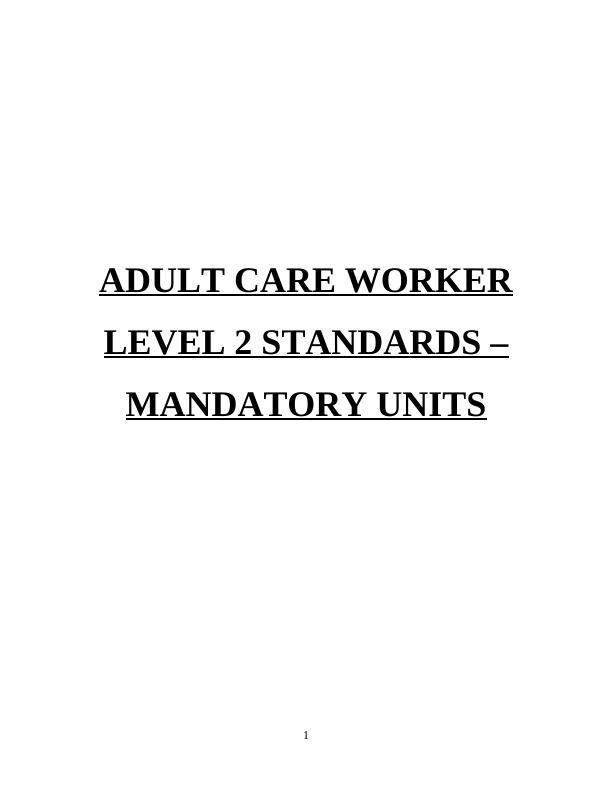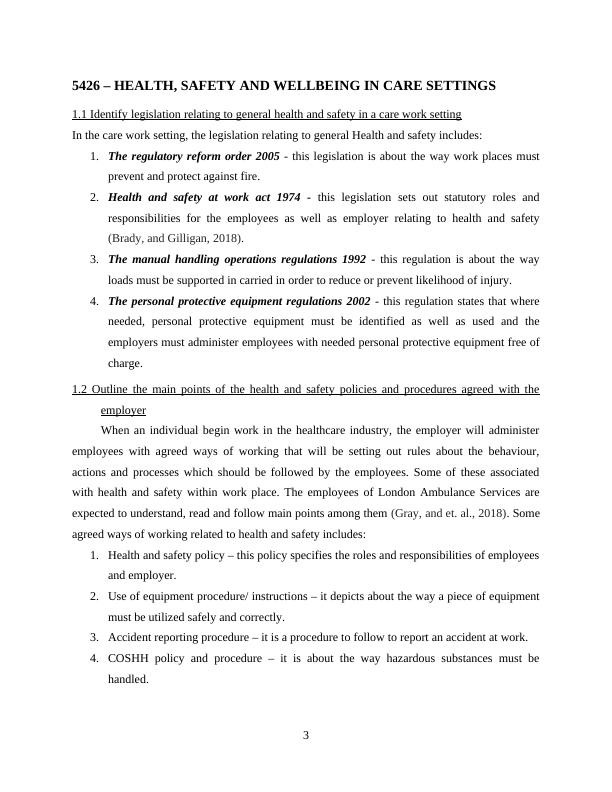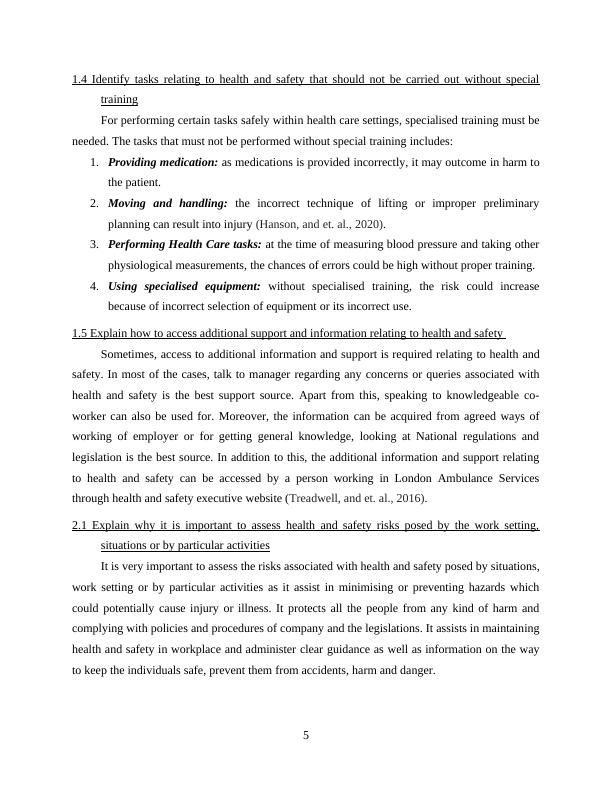Health and Safety in Care Settings
25 Pages7663 Words76 Views
Added on 2023-01-05
About This Document
This document provides information on health and safety in care settings, including legislation, policies, and procedures. It outlines the responsibilities of employees and employers in preventing and controlling infections. It also explains safe practices for moving and handling equipment and hazardous substances. The content covers various topics such as identifying legislation, outlining procedures, accessing support, assessing risks, reporting potential risks, addressing dilemmas, describing accidents and sudden illnesses, explaining roles and responsibilities, understanding causes and spread of infections, identifying legislation related to moving and handling, describing hazardous substances, and practicing fire prevention.
Health and Safety in Care Settings
Added on 2023-01-05
ShareRelated Documents
ADULT CARE WORKER
LEVEL 2 STANDARDS –
MANDATORY UNITS
1
LEVEL 2 STANDARDS –
MANDATORY UNITS
1

2

5426 – HEALTH, SAFETY AND WELLBEING IN CARE SETTINGS
1.1 Identify legislation relating to general health and safety in a care work setting
In the care work setting, the legislation relating to general Health and safety includes:
1. The regulatory reform order 2005 - this legislation is about the way work places must
prevent and protect against fire.
2. Health and safety at work act 1974 - this legislation sets out statutory roles and
responsibilities for the employees as well as employer relating to health and safety
(Brady, and Gilligan, 2018).
3. The manual handling operations regulations 1992 - this regulation is about the way
loads must be supported in carried in order to reduce or prevent likelihood of injury.
4. The personal protective equipment regulations 2002 - this regulation states that where
needed, personal protective equipment must be identified as well as used and the
employers must administer employees with needed personal protective equipment free of
charge.
1.2 Outline the main points of the health and safety policies and procedures agreed with the
employer
When an individual begin work in the healthcare industry, the employer will administer
employees with agreed ways of working that will be setting out rules about the behaviour,
actions and processes which should be followed by the employees. Some of these associated
with health and safety within work place. The employees of London Ambulance Services are
expected to understand, read and follow main points among them (Gray, and et. al., 2018). Some
agreed ways of working related to health and safety includes:
1. Health and safety policy – this policy specifies the roles and responsibilities of employees
and employer.
2. Use of equipment procedure/ instructions – it depicts about the way a piece of equipment
must be utilized safely and correctly.
3. Accident reporting procedure – it is a procedure to follow to report an accident at work.
4. COSHH policy and procedure – it is about the way hazardous substances must be
handled.
3
1.1 Identify legislation relating to general health and safety in a care work setting
In the care work setting, the legislation relating to general Health and safety includes:
1. The regulatory reform order 2005 - this legislation is about the way work places must
prevent and protect against fire.
2. Health and safety at work act 1974 - this legislation sets out statutory roles and
responsibilities for the employees as well as employer relating to health and safety
(Brady, and Gilligan, 2018).
3. The manual handling operations regulations 1992 - this regulation is about the way
loads must be supported in carried in order to reduce or prevent likelihood of injury.
4. The personal protective equipment regulations 2002 - this regulation states that where
needed, personal protective equipment must be identified as well as used and the
employers must administer employees with needed personal protective equipment free of
charge.
1.2 Outline the main points of the health and safety policies and procedures agreed with the
employer
When an individual begin work in the healthcare industry, the employer will administer
employees with agreed ways of working that will be setting out rules about the behaviour,
actions and processes which should be followed by the employees. Some of these associated
with health and safety within work place. The employees of London Ambulance Services are
expected to understand, read and follow main points among them (Gray, and et. al., 2018). Some
agreed ways of working related to health and safety includes:
1. Health and safety policy – this policy specifies the roles and responsibilities of employees
and employer.
2. Use of equipment procedure/ instructions – it depicts about the way a piece of equipment
must be utilized safely and correctly.
3. Accident reporting procedure – it is a procedure to follow to report an accident at work.
4. COSHH policy and procedure – it is about the way hazardous substances must be
handled.
3

5. Hazard reporting procedure – this is a procedure to follow for reporting a potential hazard
within the workplace.
6. Fire/ evacuation procedure – this is the procedure about what to do if there is a fire
7. Personal care procedure – this procedure is about how personal care must be carried out
1.3 Outline the main health and safety responsibilities of:
Self:
The main health and safety responsibilities in relation to self includes:
1. Attending health and safety training
2. Adhere to warning signs
3. Report any injuries, accidents, or disease
4. Adhere to agreed working ways, policies and procedures
5. Use Personal Protective Equipment as instructed your employer
6. Whistle blow if necessary
7. Use welfare facilities
The employer or manager:
The main responsibilities of employer or manager in relation to health and safety includes:
1. Provide necessary training
2. Provide adequate work equipment
3. Offer welfare facilities
4. Provide PPE for free
5. Document emergency procedures
6. Offer safety signage as well as warning labels
7. Report disease, incidents, or dangerous occurrences
Others in the work setting:
The main roles and responsibilities of others in work settings includes:
1. Report hazards and risks
2. Take reasonable care for themselves and others
3. Comply with health and safety procedures
4
within the workplace.
6. Fire/ evacuation procedure – this is the procedure about what to do if there is a fire
7. Personal care procedure – this procedure is about how personal care must be carried out
1.3 Outline the main health and safety responsibilities of:
Self:
The main health and safety responsibilities in relation to self includes:
1. Attending health and safety training
2. Adhere to warning signs
3. Report any injuries, accidents, or disease
4. Adhere to agreed working ways, policies and procedures
5. Use Personal Protective Equipment as instructed your employer
6. Whistle blow if necessary
7. Use welfare facilities
The employer or manager:
The main responsibilities of employer or manager in relation to health and safety includes:
1. Provide necessary training
2. Provide adequate work equipment
3. Offer welfare facilities
4. Provide PPE for free
5. Document emergency procedures
6. Offer safety signage as well as warning labels
7. Report disease, incidents, or dangerous occurrences
Others in the work setting:
The main roles and responsibilities of others in work settings includes:
1. Report hazards and risks
2. Take reasonable care for themselves and others
3. Comply with health and safety procedures
4

1.4 Identify tasks relating to health and safety that should not be carried out without special
training
For performing certain tasks safely within health care settings, specialised training must be
needed. The tasks that must not be performed without special training includes:
1. Providing medication: as medications is provided incorrectly, it may outcome in harm to
the patient.
2. Moving and handling: the incorrect technique of lifting or improper preliminary
planning can result into injury (Hanson, and et. al., 2020).
3. Performing Health Care tasks: at the time of measuring blood pressure and taking other
physiological measurements, the chances of errors could be high without proper training.
4. Using specialised equipment: without specialised training, the risk could increase
because of incorrect selection of equipment or its incorrect use.
1.5 Explain how to access additional support and information relating to health and safety
Sometimes, access to additional information and support is required relating to health and
safety. In most of the cases, talk to manager regarding any concerns or queries associated with
health and safety is the best support source. Apart from this, speaking to knowledgeable co-
worker can also be used for. Moreover, the information can be acquired from agreed ways of
working of employer or for getting general knowledge, looking at National regulations and
legislation is the best source. In addition to this, the additional information and support relating
to health and safety can be accessed by a person working in London Ambulance Services
through health and safety executive website (Treadwell, and et. al., 2016).
2.1 Explain why it is important to assess health and safety risks posed by the work setting,
situations or by particular activities
It is very important to assess the risks associated with health and safety posed by situations,
work setting or by particular activities as it assist in minimising or preventing hazards which
could potentially cause injury or illness. It protects all the people from any kind of harm and
complying with policies and procedures of company and the legislations. It assists in maintaining
health and safety in workplace and administer clear guidance as well as information on the way
to keep the individuals safe, prevent them from accidents, harm and danger.
5
training
For performing certain tasks safely within health care settings, specialised training must be
needed. The tasks that must not be performed without special training includes:
1. Providing medication: as medications is provided incorrectly, it may outcome in harm to
the patient.
2. Moving and handling: the incorrect technique of lifting or improper preliminary
planning can result into injury (Hanson, and et. al., 2020).
3. Performing Health Care tasks: at the time of measuring blood pressure and taking other
physiological measurements, the chances of errors could be high without proper training.
4. Using specialised equipment: without specialised training, the risk could increase
because of incorrect selection of equipment or its incorrect use.
1.5 Explain how to access additional support and information relating to health and safety
Sometimes, access to additional information and support is required relating to health and
safety. In most of the cases, talk to manager regarding any concerns or queries associated with
health and safety is the best support source. Apart from this, speaking to knowledgeable co-
worker can also be used for. Moreover, the information can be acquired from agreed ways of
working of employer or for getting general knowledge, looking at National regulations and
legislation is the best source. In addition to this, the additional information and support relating
to health and safety can be accessed by a person working in London Ambulance Services
through health and safety executive website (Treadwell, and et. al., 2016).
2.1 Explain why it is important to assess health and safety risks posed by the work setting,
situations or by particular activities
It is very important to assess the risks associated with health and safety posed by situations,
work setting or by particular activities as it assist in minimising or preventing hazards which
could potentially cause injury or illness. It protects all the people from any kind of harm and
complying with policies and procedures of company and the legislations. It assists in maintaining
health and safety in workplace and administer clear guidance as well as information on the way
to keep the individuals safe, prevent them from accidents, harm and danger.
5

2.2 Explain how and when to report potential health and safety risks that have been identified
While working within the organisation, an individual may come across various potential
risks associated with health and safety. These includes blocked fire exit, exposed wiring, wet
floor etc. This makes it crucial to understand when and how to report the identified risks. The
risks must be reported as early as possible to relevant individual. The person will usually be
manager or health and safety officer. In case of any kind of doubt, speaking to manager or
looking at policies and procedures of employer for guidance is an appropriate way. Minor
hazards can be resolved by themselves (Nabbout, and et. al., 2017). For example: in London
Ambulance Services, if a box is placed in a way of fire exit and an individual is able to lift it,
then they can simply move it to safer place. This hazard still be reported to manager or health
and safety officer so that appropriate action can be taken in order to prevent it from happening.
Reporting of risk can be done verbally and in written form by filling a form.
2.3 Explain how risk assessment can help address dilemmas between rights and health and safety
concerns
Dilemmas generally arise from conserving the rights of individuals while maintaining
health and safety. In health and social care settings, it is a common dilemma that the choices of
an individual sometimes do not comply with the rules associated with health and safety. Thus,
risk assessment need to take place so that control measures can be executed which can prevent
the rights of the individuals along with the health and safety concerns. The main rights of the
individual are to be free from danger, abuse and harm which can only be accomplished through
maintaining health and safety of people. Risk assessment assist in determining and assessing
risks related to health and safety of an individual and execute control measures in order to
eliminate risks and keep the individuals safe from danger and harm. Thus, risk assessment aids in
protecting the rights of individuals along with maintaining their concerns associated with health
and safety at the same time (Goralski, Nasr, and Uluer, 2017).
3.1 Describe different types of accidents and sudden illnesses that may occur in own work setting
There are many types of sudden illnesses and accidents that may occur within health and
care settings. Accidents are the unexpected and unintended incidents which may results in
damage or injury. In order to reduce likelihood of happening risk, assessments must be
performed. Different types of accidents that may occur in work settings includes:
1. Slips and trips
6
While working within the organisation, an individual may come across various potential
risks associated with health and safety. These includes blocked fire exit, exposed wiring, wet
floor etc. This makes it crucial to understand when and how to report the identified risks. The
risks must be reported as early as possible to relevant individual. The person will usually be
manager or health and safety officer. In case of any kind of doubt, speaking to manager or
looking at policies and procedures of employer for guidance is an appropriate way. Minor
hazards can be resolved by themselves (Nabbout, and et. al., 2017). For example: in London
Ambulance Services, if a box is placed in a way of fire exit and an individual is able to lift it,
then they can simply move it to safer place. This hazard still be reported to manager or health
and safety officer so that appropriate action can be taken in order to prevent it from happening.
Reporting of risk can be done verbally and in written form by filling a form.
2.3 Explain how risk assessment can help address dilemmas between rights and health and safety
concerns
Dilemmas generally arise from conserving the rights of individuals while maintaining
health and safety. In health and social care settings, it is a common dilemma that the choices of
an individual sometimes do not comply with the rules associated with health and safety. Thus,
risk assessment need to take place so that control measures can be executed which can prevent
the rights of the individuals along with the health and safety concerns. The main rights of the
individual are to be free from danger, abuse and harm which can only be accomplished through
maintaining health and safety of people. Risk assessment assist in determining and assessing
risks related to health and safety of an individual and execute control measures in order to
eliminate risks and keep the individuals safe from danger and harm. Thus, risk assessment aids in
protecting the rights of individuals along with maintaining their concerns associated with health
and safety at the same time (Goralski, Nasr, and Uluer, 2017).
3.1 Describe different types of accidents and sudden illnesses that may occur in own work setting
There are many types of sudden illnesses and accidents that may occur within health and
care settings. Accidents are the unexpected and unintended incidents which may results in
damage or injury. In order to reduce likelihood of happening risk, assessments must be
performed. Different types of accidents that may occur in work settings includes:
1. Slips and trips
6

End of preview
Want to access all the pages? Upload your documents or become a member.
Related Documents
Health and Safety in Health and Social Care (Doc)lg...
|14
|2802
|162
Health and Safety Well-Beinglg...
|15
|4458
|97
Promote Health, Safety and Well-being in Care Settingslg...
|9
|2008
|95
Health Safety and Wellbeing in Health and Social Care Settingslg...
|19
|1559
|214
Health and safety in health and social carelg...
|12
|3884
|182
Risk Management in Healthcarelg...
|13
|814
|91
